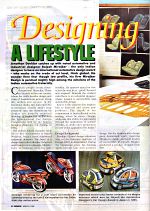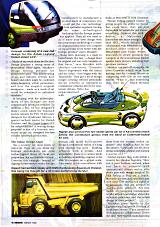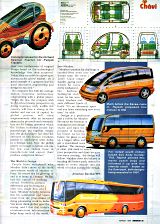 |
PRESS
PRESS
|
|
|
March 1999
Jonathan Davidar/PFS Designing a Lifestyle
The person whose character adds life to this environment is Rajesh Mirajker, India's most renowned industrial designer. The head of a design firm called Mirajker Industrial and Transportation Design, Mirajker lives in Chennai with his wife Surekha. He appears quiet but that is just the way he is - gutsy, focused and inspired. Beneath the studied calm there is an industrial designer whose passion is automobiles and automobile design. And it is this passion that inspires him to innovate and create new products. The depth of his commitment is best reflected in his writing, where he states: "Design addresses that ability for innovation through the application of science and arts, to clothe one's products in a form which appeals to the buyer." Design Background Mirajker's formal design education was at the National Institute of Design (NID) in Ahmedabad. During the foundation years, his drawing skills helped him with product design. But the dormant auto design gene demanded more, inspiring Mirajker to design and build models of automobiles. Eventually Mirajker graduated a product designer from NID. From there he moved to the Art Center College of Design in Switzerland. "Here," he says, "is where I gained the insight to mould function and form into my designs." For Mirajker, design is taking a product from the drawing board to completion, right to the point of solving production line problems. "Design is all about a long-term investment for the foreseeable future of the country," states Mirajker. One thing is clear - he moves with the industry to create products that work. "The industrial sector is slowly waking up to the the reality of having to survive by innovation -- and people are becoming more aware of design," he remarks with satisfaction. Work that inspires is often rewarded, and Mirajker has bagged international awards for his designs. The recognition has been reassuring (a designer's world often swims against the tide). In 1991, Mirajker won a Japanese design competition, where the brief was to design a small a car suited to city travel. In 1995, a revised version of the Megha won a design contest for a multipurpose vehicle, which was held by the Automotive Designer's Association. Mirajker says, "The car's Indianess appealed and I won." His most recent achievement is a CAD design award announced in late 1998. Mirajker's Aquajack won the Design Your World contest conducted by Autodesk and IBM. The Aquajack, designed for Sharp Tools in Coimbatore, is an electronic switchgear designed to automate the entire water pumping process. The benefits are many - water and electricity are saved, repair costs and damage costs of pumps are lowered, and all that with an unmonitored process. Right now, India's auto enthusiast climate is electric. And Mirajker's perspective on the right Indian vehicle is interesting. "An affordable, multipurpose minivan with both highway and city driving characteristics would be ideal - we Indians love carrying around lots of odds and ends!" Design Approach
In keeping with his philosophy, many of his designs are now commercially produced vehicles. To mention a few, he has designed a luxury coach called the Suncoach and its variants for TVS; 35-40 tonne dumpers for Hindustan Motors; a special orchard tractor for Punjab Tractors; and the Comet Junior LCV for Ashok Leyland. A riveting design proposal is that of a futuristic two-seater sports car, designed for low volume handbuilt production. The lndian Design Angle "As a country we must learn to innovate. How do you think the foreign automakers get core technologies? Many of them are proprietary that are available for sale. Consider this example: Instead of signing a joint venture with a foreign manufacturer to manufacture a product made of composites, you could get the core technology from specialist suppliers, having the same technological backdrop that the foreign partner has applied. Then all you need to do is marry your own design with this proprietary technology to create an original product that will compete on equal terms if not better with the foreign product," states Mirajker.
"Maruti Udyog created history by giving people the ability to choose. But years later, they are still dependent on Suzuki for just about everything. Contrast this with Proton, a Malaysian automaker ten years younger than MUL, which initially collaborated with Mitsubishi to produce older versions of Mitsubishi's cars. Today, Proton innovates to create products that compete in the international market against major players, including their previous partners." Mirajker can reel off examples. He cites Daewoo which went from making cars for General Motors to competing with GM on the same market. "What is that something that they do which elevates them from the average Indian car maker?" asks Mirajker. And he has the answer, "Ultimately it is all about doing something original and making a success of it." Global markets may exist within a country but Mirajker wonders, "How can a joint venture succeed when you have to compete with international majors within who won't part with design insights? It's like being a dog on a leash. Mercedes for instance, wouldn't part with their core intellectual rights or technologies that are integral to making their products. For that matter, no competent manufacturer would impart knowledge about the technical processes and the actual design of their product." Mirajker gives kudos to the Earthmoving Equipment Division of Hindustan Motors. "They started out with American collaborators. Down the line, they started manufacturing their own earthmovers of original design based on the technological knowledge that they acquired. Today, they successfully export earth movers in the global market - it's a good example of a company that has used innovative engineering and design to succeed."
The World is Design People have wondered why Mirajker didn't move to the more auto-vibrant world of Mumbai or Pune. He retorts that he grew up in and is at home in Chennai. He has had the option of working abroad. However, cultural differences and his being the only son, made him stay back. Mirajker fiercely believes that his satisfaction and vision come from the proposition of doing pioneering work in India. "Act local, think global, goes the saying, and I feel that today's communication infrastructure helps keep track of the world," says Mirajker. Mirajker's passion for challenge is carried over even into his leisure time. He owns a Laser Class single-hander, racing yacht which he races every weekend in the harbour. Sailing at club level, he has won many trophies and sails different kinds of boats. "It's an adventure sport and you learn something new every time", he adds. Design is a profession and a hobby for Mirajker. He enjoys the freedom of running his own design studio and likes the prospect of building his brand. As for the future, he plans to set up a bigger office and get a specialised team together. The message is clear, you need to widen your perspective and think because you enjoy creating... the design will follow. Mirajker does not believe in treading the beaten path, instead he wants to create inroads into the world of Indian automobile design. |
|
| About us |
| Services |
| Highlights |
| Contact |
| Portfolio |
| Automotive |
| Product Design |
| Off Highway |
| Farm |
| Recreation |
| Aerospace |
| Concepts |
All rights reserved. © Mirajker Design 2003
 Certain people create three- dimensional lifestyles. There are worlds within our country where the walls breathe design and rows of bookshelves gesture about life, models and success. In the functional studio, two high-end CAD workstations silently attract your attention. And the illustrations on display are actually technical drawings of Megha, the car that won the International Car Design Competition held by the famous Japanese magazine Car Styling, in 1991.
Certain people create three- dimensional lifestyles. There are worlds within our country where the walls breathe design and rows of bookshelves gesture about life, models and success. In the functional studio, two high-end CAD workstations silently attract your attention. And the illustrations on display are actually technical drawings of Megha, the car that won the International Car Design Competition held by the famous Japanese magazine Car Styling, in 1991. When an idea strikes, Mirjaker works fast. He attributes his visualising prowess to his childhood days. "I played extensively with Japanese electromechanical toys with a high level of detail. This helped me get a feel for thinking and working in 3-D space." He prefers to work on paper, getting the basic layout and dimensions of his designs in place, before moving to the computer. On the computer, he does surface modelling, component design engineering and individual part modelling before rendering a complete virtual model. Much of the work done by Mirajker Design displays a strong sense of practicality. Here again, Mirajker's design writing presents his perspective aptly: "The interweaving of art and industry reveals how beauty and utility might be combined when designing within parameters, and how the singular original workpiece - made as a work of art could be reiterated in unlimited numbers."
When an idea strikes, Mirjaker works fast. He attributes his visualising prowess to his childhood days. "I played extensively with Japanese electromechanical toys with a high level of detail. This helped me get a feel for thinking and working in 3-D space." He prefers to work on paper, getting the basic layout and dimensions of his designs in place, before moving to the computer. On the computer, he does surface modelling, component design engineering and individual part modelling before rendering a complete virtual model. Much of the work done by Mirajker Design displays a strong sense of practicality. Here again, Mirajker's design writing presents his perspective aptly: "The interweaving of art and industry reveals how beauty and utility might be combined when designing within parameters, and how the singular original workpiece - made as a work of art could be reiterated in unlimited numbers."  "Long term planning is a must to build brands that last - a design must be original and can only compete on that basis," says Mirajker with absolute conviction. "Consider Telco's experiment with the Indica and the Safari - they began with the Tatamobile. They got a lot of design insight creating refined personally driven vehicles as opposed to commercial vehicles driven by non-owner drivers. Telco has experimented with design and made home-grown design a commercial reality. It's long term strategy that pays - building vehicles with a vision. And importantly, there is a certain pride in building something original, to be able to compete on a global, scale. Tata wants to be synonymous with India as Mercedes is with Germany.
"Long term planning is a must to build brands that last - a design must be original and can only compete on that basis," says Mirajker with absolute conviction. "Consider Telco's experiment with the Indica and the Safari - they began with the Tatamobile. They got a lot of design insight creating refined personally driven vehicles as opposed to commercial vehicles driven by non-owner drivers. Telco has experimented with design and made home-grown design a commercial reality. It's long term strategy that pays - building vehicles with a vision. And importantly, there is a certain pride in building something original, to be able to compete on a global, scale. Tata wants to be synonymous with India as Mercedes is with Germany. He compares this with the average Indian business technocracy collaborating with a global player: "Down the line, the company with its old-school insular perspective on doing business only within the country will face a slump in the market and run out of capital. Its global partner will then, magnanimously offer an increased share in the proceeds and eventually buy out the Indian operation which the Indian business house has painstakingly put together. Simply put, the global player has used the services of the Indian business partner to comfortably settle down in a foreign land. Now the global player, no longer a partner can use the low cost Indian base to manufacture and export their produce using local labour."
He compares this with the average Indian business technocracy collaborating with a global player: "Down the line, the company with its old-school insular perspective on doing business only within the country will face a slump in the market and run out of capital. Its global partner will then, magnanimously offer an increased share in the proceeds and eventually buy out the Indian operation which the Indian business house has painstakingly put together. Simply put, the global player has used the services of the Indian business partner to comfortably settle down in a foreign land. Now the global player, no longer a partner can use the low cost Indian base to manufacture and export their produce using local labour."